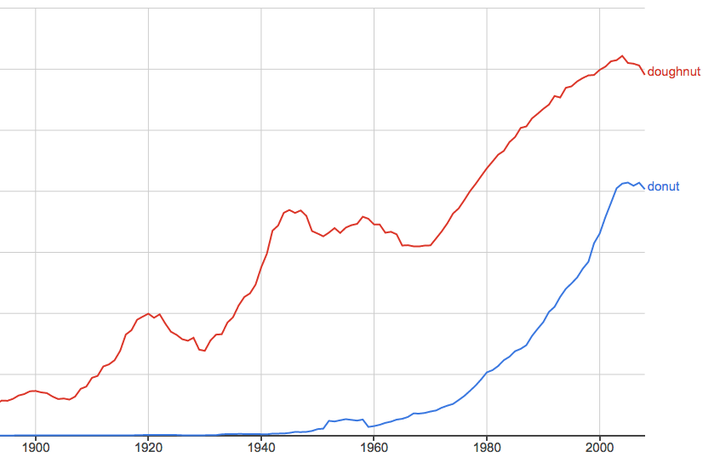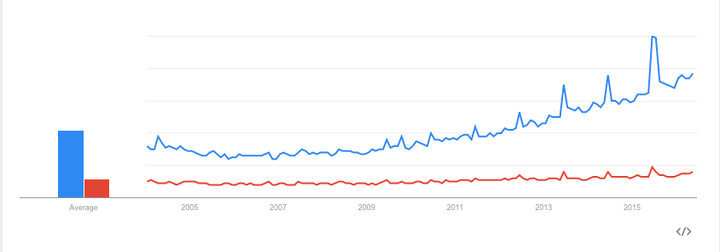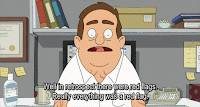 It appears for illustration purposes as Downtown, even though there is no point of comparison or what is normally associated with it - Uptown.
It appears for illustration purposes as Downtown, even though there is no point of comparison or what is normally associated with it - Uptown.Doughnut Or Donut? The Great Spelling Debate Of Our Time
We're about to take you on a quest to discover the term's origin, and its inevitable path toward ruin. You may want to grab a doughnut for this one.
Doughnuts have become an integral part of American culture, loved for providing us with mouths full of comfort and loathed for ruining our diets. Beyond this love/hate relationship is another duality we apparently feel very passionately about: The correct spelling. Is it doughnut or donut?
_____________________________________________________________________________
MEET THE NEW DONUT with inner rings and outer rings and that "Old Hole" - look what it has now become - Inner Suburbs (some more outer than others) and something new called "Collar Counties" that can restrict or expand more suburbs to create Endless Suburban Sprawl
_____________________________________________________________________________
It's difficult to pin down the exact date of the doughnut's inception, but it's quite clear that the first printed mention of the fried treat referred to it as "dough-nut," spelled out to its full glory (and with an added hyphen). In 1809, Washington Irving wrote lovingly of the foodstuff in "A History of New York, from the Beginning of the World to the End of the Dutch Dynasty:"
“Sometimes the table was graced with immense apple-pies, or saucers full of preserved peaches and pears; but it was always sure to boast of an enormous dish of balls of sweetened dough, fried in hog’s fat, and called dough-nuts, or oly koeks: a delicious kind of cake, at present scarce known in this city, excepting in genuine Dutch families.”
(Oly koeks translates to "oily cakes," a far less appetizing name than doughnuts. Just imagine -- if they were still called "oily cakes" today, do you think we'd have two food holidays named after them? Would Homer Simpson have ever uttered the phrase, "Mmmmm, oily cakes?" But we digress.)
At some point -- a very low point in our history, if you ask some -- the term "donut" came into being. According to Merriam-Webster, "donut" has appeared in published, edited text since the mid-20th century, and it may have gained momentum thanks to phonetic-based spelling reform, of which Benjamin Franklin and Noah Webster were fond. That tradition turned words like catalogue into catalog, through into thru, and ... doughnut into donut.
But the real culprit is likely Dunkin' Donuts, which launched -- you guessed it -- smack in the middle of the 20th century, aka 1950. The following graph from Google Books Ngram shows data from 1900 to 2008, comparing the number of references from published literature for the terms doughnut and donut. Though it shows that doughnut has always been favored in the world of publishing, it's important to note the donut spike right after 1950 ...

While the graph above shows doughnut is the favored term in the publishing world (and it's also the preferred term among grammar nuts on the site Grammarly), the opposite is true on the internet.
A comparison of the performance of doughnut vs. donut between 2004-2016 via Google Trends yields donut as the clear winner. (Thus proving the internet doesn't give two hoots about formal grammar.)

These days, most official style guides and dictionaries prefer the term doughnut. The AP Stylebook favors doughnut, to conform with Webster's New World College Dictionary, the Stylebook's primary reference. Score two points for doughnut.
Another dictionary officially favors doughnut as well. A search for the term "donut" on Merriam-Webster suggests that donut is only a variant of doughnut. Three points for doughnut.
So which spelling is correct? Both. Doughnut is preferred by style guides and dictionaries, but donut has become an acceptable substitute in our lexicon.
Here at HuffPost, we've been waging an inner battle for years, at times fluctuating (15 Donut Holes That Are Better Than Actual Donuts, vs. The Greatest Homemade Doughnut Recipes You'll Ever Find). Because donut is the higher-searched-for term (and we naturally want to win the internet), we've often been tempted to go with "donut." But our hearts are telling us to go with "doughnut," and here's why.
Doughnuts deserve every letter they can get. They have, after all, fried in hot vats of oil for us. When we take the "ugh" out of doughnuts, we're extracting the three letters that embody the feeling of disappointed doughnuts all around the world: Ugh.
Don't disappoint the doughnut
===========================================================================
FOOD FOR THOUGHT >
The New Donut
Former Indianapolis Mayor Bill Hudnut used to like to say that “you can’t be a suburb of nowhere.” This is the oft-repeated notion has been a rallying cry for investments to revitalize downtowns in America for three decades or so now. The idea being that you can’t have a smoking hole in your region where your downtown is supposed to be. This created a mental based on a donut. You can’t let downtown become an empty hole. For reason that will become apparent soon, I call this model “the old donut”:
These efforts have paid off to a certain degree. Most big city downtowns have done very well as entertainment and visitor districts, eds and meds centers, etc. More recently we’ve seen an influx of residents, even in places where the overall city or even region has struggled or declined. Cleveland added about 4,000 net new downtown residents in the 2000s. St. Louis added 3,000. With most cities in some stage of an apartment building spree consisting of a few thousand units, these numbers should only improve.
Key weaknesses remain in private sector employment (declining in most places) and retail (not enough high income residents yet). And other than the tier one types of cities like Chicago, few places seem to have reached a sustainable market rate development level yet – pretty much everything is getting public assistance. Yet its pretty evident that most larger downtowns have made huge strides and are experiencing overall reasonable health.
In short, the donut hole has been filled in. Where does that leave us? I’d argue with a paradigm I call “the new donut”:
You see this in the population figures. Wendell Cox cranked the numbers and found that major metro areas gained 206,000 residents in the two mile radius from the center, but lost 272,000 residents from the 2-5 mile ring. Growth picked up strongly beyond that arc. This is the new donut area, though the start and end of it vary by metro and some have thicker rings of challenge than others.
We’ve got three decades of experience in downtown revitalization, but much less in dealing with this newer challenge zone. I’ve said that suburban revitalization may prove to be the big 21st century “urban” challenge. This is where it is happening in many cases. These areas have an inferior housing stock (often small post-war worker cottages or ranches), sometimes poor basic infrastructure, and are sometimes independent municipalities that, like Ferguson, MO, are often overlooked unless something really bad happens. Unlike the major downtown, they are often “out of sight, out of mind” for most regional movers and shakers.
What’s more, while downtown provides a concentrated location for massive public investment, this more spread out area is too big to fix by throwing money at it. And how many stadiums and convention centers does a region need in any event?
This is where we need to be doing a lot of thinking about how to bring these places back, look at what’s being done, etc. And also, given the inequality in the country, to try to think about ideas that don’t involve gentrification. One project that appears to be in this kind of zone, for example, is Atlanta’s Beltline project, though there’s a gentrifying aspect to this one. Regions that figure this one out will be at a big advantage going forward.



No comments:
Post a Comment